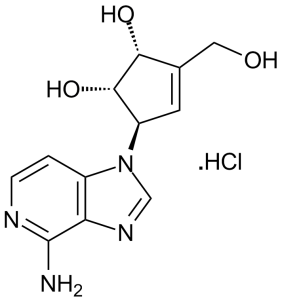This product is for research use only, not for human use. We do not sell to patients.

| Size | Price | Stock |
|---|---|---|
| 100mg | $2450 | Check With Us |
| 200mg | $3675 | Check With Us |
| 500mg | $6200 | Check With Us |
Cat #: V0384 CAS #: 120964-45-6 Purity ≥ 98%
Description: 3-deazaneplanocin A HCl (known also as DZNep; C-c3Ado; NSC-617989), the hydrochloride salt of 3-deazaneplanocin A which is an adenosine analog, is a novel and competitive inhibitor of S-adenosylhomocysteine hydrolase and also an EZH2 (histone methyltransferase) inhibitor with anticancer activity.
Publications Citing InvivoChem Products
Product Promise

- Physicochemical and Storage Information
- Protocol
- Related Biological Data
- Stock Solution Preparation
- Quality Control Documentation
| Molecular Weight (MW) | 298.73 |
|---|---|
| Molecular Formula | C12H14N4O3.HCl |
| CAS No. | 120964-45-6 |
| Storage | -20℃ for 3 years in powder formr |
| -80℃ for 2 years in solvent | |
| Solubility In Vitro | DMSO: 52 mg/mL (174.1 mM)r |
| Water: 52 mg/mL (174.1 mM)r | |
| Ethanol: <1 mg/mL | |
| SMILES Code | O[C@@H]1[C@H](O)C(CO)=C[C@H]1N2C=NC3=C2C=CN=C3N.[H]Cl |
| Synonyms | NSC 617989 HCl; NSC-617989 HCl; 3-deazaneplanocin A HCl; 3-deazaneplanocin A hydrochloride; DZNep; NSC617989; |
| Protocol | In Vitro | 3-Deazaneplanocin A (DZNep) hydrochloride is a potent histone methyltransferase EZH2 inhibitor. Treatment of OCI-AML3 cells with 3-Deazaneplanocin A (1.0 μM) results in a significant increase in accumulation of cells in the G0/G1 phase (58.5%) with a concomitant decrease in the number of cells in S phase (35.2%) and G2/M phases (6.3%) of the cell cycle (P<0.05). Treatment with 3-Deazaneplanocin A (200 nM to 2.0 μM) for 48 hours, dose dependently, inhibits colony growth of OCI-AML3 and HL-60 cells. |
|---|---|---|
| In Vivo | The survival of NOD/SCID mice with acute myeloid leukemia (AML) due to HL-60 cells is significantly higher, if treated with 3-Deazaneplanocin A (DZNep) and LBH589 (PS) compare to treatment with PS, 3-Deazaneplanocin A, or vehicle alone (P<0.05). Median survival is as follows: control, 36 days; PS, 42 days; 3-Deazaneplanocin A, 43 days; and 3-Deazaneplanocin A plus PS, 52 days. |
| Solvent volume to be added | Mass (the weight of a compound) | |||
|---|---|---|---|---|
| Mother liquor concentration | 1mg | 5mg | 10mg | 20mg |
| 1mM | 3.3475 mL | 16.7375 mL | 33.4750 mL | 66.9501 mL |
| 5mM | 0.6695 mL | 3.3475 mL | 6.6950 mL | 13.3900 mL |
| 10mM | 0.3348 mL | 1.6738 mL | 3.3475 mL | 6.6950 mL |
| 20mM | 0.1674 mL | 0.8369 mL | 1.6738 mL | 3.3475 mL |
This equation is commonly abbreviated as: C1 V1 = C2 V2
- (1) Please be sure that the solution is clear before the addition of next solvent. Dissolution methods like vortex, ultrasound or warming and heat may be used to aid dissolving.
- (2) Be sure to add the solvent(s) in order.




































